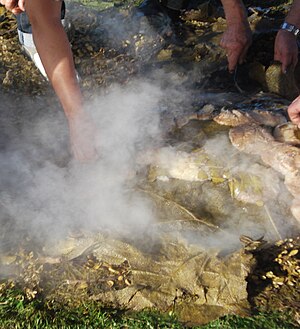 Uncovering the curanto in Calen, commune of Dalcahue, Chiloé, Chile | |
| Place of origin | Chile |
|---|---|
| Region or state | Chiloé |
| Serving temperature | Hot |
| Main ingredients | Potatoes, shellfish, meat |
| Variations | Multiple |
Curanto (from Mapudungun: kurantu 'stony') is a traditional Chilote method of cooking food using heated rocks buried in an earth oven that is covered with pangue leaves and turf. The fundamental components are seafood, potatoes, along with other traditional preparations from Chiloé Archipelago such as milcao and chapalele, to which are added meats, sausages and sometimes crustaceans.[1][2][3]
It is part of the Chilean cuisine, and it is one of the most recognized dishes of traditional Chilote cuisine whose oldest archaeological remains dates to more than eleven thousand years before present on the Greater Island;[1] there are also finds of lesser data in areas of the coastal edge of the Reloncaví Sound, the inland sea of Chiloé and the northern Patagonian channels.[4] In addition, thanks to the migratory flow of the late 19th century and early 20th century, it spread throughout the south of that country.[5][6]
Although its preparation has been documented in various ethnographic accounts since the 16th century,[7][8] traditionally in the cuisine of the Chiloé archipelago it is prepared outdoors and is called "curanto en hoyo", since it is made in a pit in the ground, about half a meter deep; the bottom is covered with stones, which are heated in a campfire. When they are red hot, the firebrands are removed and the ingredients begin to be placed.
- ^ a b Rivas, Pilar; Ocampo, Carlos (2002). "El antiguo curanto chilote". Fondecyt 1020616 "Proceso y orígenes del poblamiento marítimo de los canales patagónicos: Chiloé y el núcleo septentrional" (in Spanish).
- ^ Lenz, Rodolfo (1910). Diccionario etimológico (in Spanish). Santiago: Universidad de Chile, Seminario Filológico Hispano.
- ^ Cavada, Francisco (1910). Apuntes para un vocabulario deprovincialismos de Chiloé (República de Chile): Precedidos de una breve reseña histórica del archipiélago (in Spanish). Punta Arenas.
{{cite book}}: CS1 maint: location missing publisher (link) - ^ Sade Martínez, Kémel; Osorio Pefaur, Mauricio; Pérez-Barría, Leonardo (2016). Chonos, curantos y hachas talladas en momentos de contacto en el Fiordo Aysén e islas adyacentes (Región de Aysén, Chile).
- ^ Riveros Quinteros, Katherine; Fernández Génova, Macarena (2018). "Chiloé en otro lugar. Memorias de migraciones a Punta Arenas". Sophia Austral (in Spanish) (22): 137–161. doi:10.4067/S0719-56052018000200137. S2CID 239538497.
- ^ Muñoz Aguilar, Silvana Andrea (2015). Influencia de la identidad social chilota en la identidad regional Magallánica (in Spanish). Santiago: Facultad de Ciencias Sociales, Universidad de Chile.
- ^ Pérez Rosales, Vicente (1886). Recuerdos del pasado: 1814-1860. Santiago de Chile: Imprenta Gutenberg.
- ^ Martin, Carl (1870). "VIII. Kleinere Mittheilungen. 1. Die Chiloten. Aus einem Schreiben von Dr. Carl Martin, Arzt in Puerto Montt (Sud-chile), 20. December 1869". Archiv für Anthropologie: Zeitschrift für Naturgeschichte und Urgeschichte der Menschen (in German): 140–141.